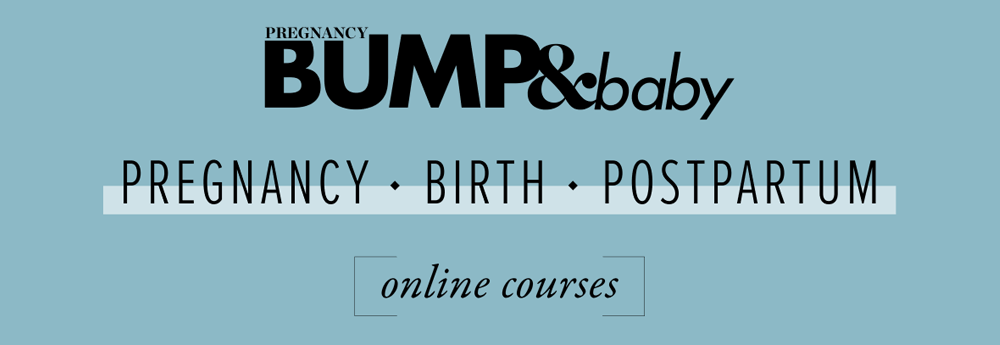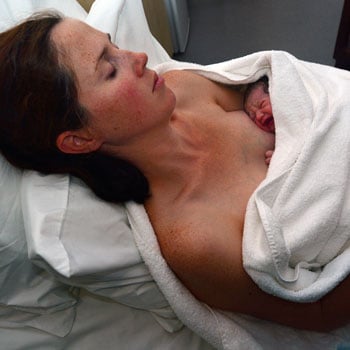
Your body will need time to heal following the birth of your baby, explains Kelly Eden-Calcott.
I thought I was pretty prepared for my first birth. And I was – it went how I expected it to (a bit earlier and quicker than I expected, but there weren’t too many surprises). That is, until after the birth.
All the after-birth books I had read were about caring for my baby. I had my burping techniques DVD, sleep sack, ergonomic baby carrier – I was ready! What I hadn’t thought about was what my body would be doing.
In my head, I imagined birth would go along the lines of: Delivery, baby in my arms, snuggly photos, and that’s it, all done. In reality, it was a bit different.
Straight after delivery
I was too polite to yell, “Will you just get away from my vagina!” at my very nice midwife, but seriously, there was a lot of poking and prodding going on after you’ve already done all the hard work of pushing a baby out. They call it the third stage of labour, which is when you deliver the placenta and your midwife will usually press down firmly on your stomach to check your uterus is contracting. Then you’re checked for tears and, if you’ve torn or if you’ve had a episiotomy, you’ll be stitched up.
To be fair, you’ll be so busy greeting your new bub and feeling amazed that you might not register much of what is happening down there. It’s all for your own good, after all. Your midwife wants to know you’re not going to hemorrhage everywhere and have any bits left unattended, but still, it can be a bit of a surprise.
First- and second-degree tears are common, usually in the perineal area between your vagina and anus, but they typically only need a few (if any) stitches and heal quickly.
You’ll probably be shaky, tired, sweaty, and bloody, and your not-so-private-anymore parts will hurt, but you should be able to get up and have a snack and a nice warm shower (with help if you’ve had a Caesarean section) before too long.
Tears and episiotomy
An episiotomy is a cut made to the perineum to make a wider opening for baby.
Third- and fourth-degree tears are ones that extend to the rectum. These are painful and slower to heal than rst- or second-degree tears, which involve skin and a little bit of muscle only. To care for and keep your wound clean, wipe front to back on the toilet, keep sanitary pads fresh by changing them at every toilet stop, and try sitz baths, drying yourself carefully afterwards by patting with toilet paper or a clean towel, never rubbing. Breastfeed laying down to aid your pain, and don’t sit for long periods.
The first few days
And then there’s the discharge. Most women, not just me, are surprised by this. The midwife may warn you to pack maternity pads in your hospital bag if they’re not supplied by the hospital or birthing centre (and the fact they are mattress-sized should really be a clue), but with bleeding heavier than a normal period, it’s a lot of discharge.
Both vaginal and caesarean section births bleed vaginally, as it comes from the site where the placenta was attached and the shedding of the thick uterine wall that was cushioning your baby. You can’t use a tampon until you are completely healed, so stock up on maternity pads, because you’ll experience at least two weeks of bleeding, probably even up to six weeks before it completely stops. The red, heaviest bleeding should stop by two weeks, though; if it doesn’t, get checked straightaway by your midwife or GP.
For the first few days, you might get extra little gushes of blood and contractions, especially when you breastfeed. It’s just your uterus contracting back to its normal size, no need to worry. With all this blood, you won’t want to wear your best lace panties, so make cheap cotton granny undies your best friend.
In the first 24 hours, wrapped ice packs or frozen maternity pads are fantastic for taking down swelling. Some people also use arnica for bruising or witch hazel wiped on with cotton pads (check with your midwife before using these). Everything stays swollen for a few days, but after 24 hours, what you can feel is usually swollen labia from excess fluid, and ice won’t help. The fluid will disappear on its own in a couple of days.
As soon as you feel you can, start doing your pelvic floor exercises. These weird little exercises are amazing. They not only help to fix your floppy pelvic floor so you don’t leak wee when you laugh, but they also get your circulation going, which helps your stitches to heal faster and reduces swelling. Some women avoid them, thinking they will hurt, but they usually feel comfortable as long as you are doing them right.
Weeing can be scary after birth, and pooing even worse. Ural sachets can neutralise the acid in your wee and make it less “stingy”. Some people wee in the bath in the first few days, or wee in the toilet while squirting water at your vagina to flush the wees away more quickly and minimise stinging. Sometimes the tiny nerves in your bladder can be temporarily damaged, so you might not get the urge to wee. It’s important to go often anyway, like you did when you were pregnant.
Grab some stool softeners if you need to, and whatever you do, don’t hold on. It just gets bigger and more difficult to pass. Try to avoid getting constipated by making sure you eat well and drink lots of fluids. You can actually feel surprisingly energetic in the first few days after a vaginal birth, but this is not the time to redecorate the kitchen or catch up on paperwork. Resting and caring for your baby are your main jobs for now. So put down the paintbrush and the laptop, and rest. Post-birth healing is more a marathon than a sprint.
The first few weeks
The postnatal period is just really leaky. Wee and little farts can sneak out when you move, milk leaks down your top, and then there’s the hormonal crying and night sweats. There’s not much you can do about it, except more pelvic floor exercises and lots of rest. Your biggest job now is resting and getting your perineum healed.
As well as the witch hazel, breathable cotton knickers, keeping clean, and changing pads frequently, some doctors recommend sitz baths. A sitz bath is a shallow basin with warm water (you can buy them to go over your toilet seat) that you sit in for 20 minutes three times a day or, some say, every time you go to the toilet.
Our bodies are amazing and, if there haven’t been too many complications, you may be starting to feel normal again already. The more you rest, the more quickly you heal, so get someone to help for a few weeks with laundry, cooking, housework, and caring for older children. Avoid too many stairs, long walks, and vigorous exercise. Vaginal births can take six or more weeks to heal completely, and Caesarean sections 12 weeks at least.
Your stitches, if you have them, will be itchy and still sore, but around three weeks post-birth, they will reabsorb and start to feel better. With mild tears, you may not feel them at all any more, even if there is scarring. Your midwife will check your stitches, but you need to keep an eye (or a nose) out for infection. If things start to feel worse, or if there is a bad smell, you may have an infection. This is not the time to feel embarrassed; it will get much worse left untreated.
Some women find a trip to a women’s health physiotherapist is helpful for post-birth healing. They can help with pelvic oor, swelling, healing of tears, and scarring, among other things. Don’t put up with pain if it carries on. Get help.
Caesarean section
As you recover from surgery, you may feel groggy and sick for a few hours. You can get up (with your midwife’s permission) after six to eight hours, but remember, this will be a long healing process.
- Pain should decrease after four to five days, but go slowly.
- No lifting for up to six weeks anything heavier than your baby.
- No vacuuming or driving for four to six weeks.
- Keep active and do pelvic floor exercises, but avoid any fitness programme or long walks until four to six weeks after surgery.
- You can purchase special underwear to help support your wound, and massage the wound gently after about three weeks.
Pelvic floor exercises: are you doing them right?
Do
- Lift and tighten internally (like you’re holding a tampon in).
- Some lower abdomen tightening is okay.
- Think quality, not quantity.
- Combining short holds and longer ones in little bursts throughout the day is better than trying to do 100 at once.
- Keep your pelvis still.
Don’t
- Hold your breath.
- Squeeze your butt, legs, or stomach.
- Tuck up or move your pelvis.
- Do too much.
- Give up too soon – it takes around 12 weeks to start getting results.
BUMP&baby
BUMP & baby is New Zealand’s only magazine for pregnancy and early babyhood. Our team of mums and mums-to-be understand what it’s like to be pregnant in this connected age, and that’s why BUMP & Baby online is geared toward what pregnant women and new mums really want to know.
Other articles of interest
Giving birth naturally — your way
With all of the birth techniques available, how do you know which one is right for you?
Beyond the baby blues
It’s normal to feel a bit down following childbirth. But what if your feelings don’t improve, or you aren’t coping? You may have postnatal depression, also known as PND







